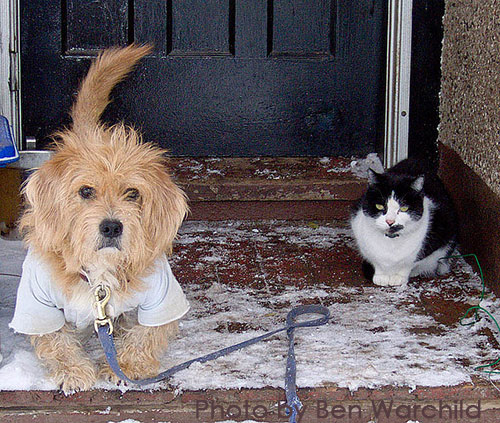Brrr… it’s cold outside! Here are 5 tips on helping our four-legged friends when the temperature dips.
-
- Bring them in. If it’s too cold for you, it’s too cold for them! Just like people, animals are subject to frostbite — especially on paws and ears. And also just like people, our elderly and very young pets are the most vulnerable. Keep them indoors as much as possible.

- Gimme shelter. Make sure animals who live outdoors have a wind-free shelter; warm, dry bedding (e.g., plenty of straw); and extra food and fresh (not frozen) water. If animals don’t have fresh water to drink, they’ll get dehydrated and won’t want to eat — which will make them sick. To keep themselves warm, animals need extra calories, ideally coming from extra protein.
- Make some noise. Outdoor cats like to sleep under car hoods. If you park outdoors, be sure to bang on your hood — or better yet, pop your hood — before starting your car and taking off. The fan belt and motor can injure them. Someone in our community recently drove to work not knowing that a cat was under his hood; thankfully, our Rescuer was able to get the cat out and have our veterinarians treat his burned paws. Tip: Look for paw prints in the snow!
- Limit your salt. Ice-melting chemicals can make animals sick, cause irritation or even death. Use paw-safe or eco-friendly products to de-ice. And to protect your pets from others’ salty sidewalks, invest in some boots or rub some paw wax or petroleum jelly on their paw pads before heading out.
- Wipe those bellies. Salt, antifreeze, or other ice-melting chemicals can find their way to your pets’ undersides and feet. Before they have a chance to lick it off and make themselves sick (or worse), wipe it off! You’ll both be glad you did.
- Bring them in. If it’s too cold for you, it’s too cold for them! Just like people, animals are subject to frostbite — especially on paws and ears. And also just like people, our elderly and very young pets are the most vulnerable. Keep them indoors as much as possible.



